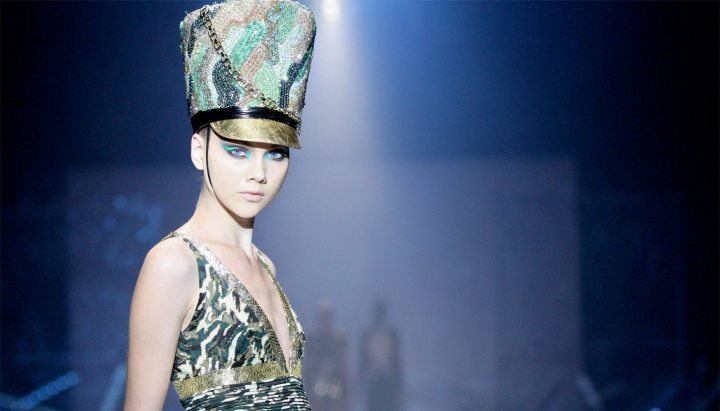Maverick Life
Chronicles of Chic: The colonel has no clothes

The Fashion Week Joburg Autumn/Winter 2013 took place at the Newtown's Mary Fitzgerald Square last weekend. Among the designers being showcased this year was the local design darling, Gavin Rajah, with a collection saturated with camouflage prints and military style. Is ‘war’ the New Cool? Or just Plain Bad Taste? By EMILIE GAMBADE.
Gavin Rajah’s CV carefully highlights the designer’s personal and business achievements, which he seems to accumulate at a regular rhythm; from opening his couture atelier in 2000, to the launch of Gavin Rajah Concept, an “Events & Interiors” company with client ranging from Nike to Jaguar, Rajah is an embodiment of a South African entrepreneur for the modern times.
Born in Durban, he studied law at the University of Cape Town before embracing fashion, designing his first dress for one of his friends during his time at UCT. The move was to be wise: Rajah borrowed R500 from his parents to start his own business and has since become one of the most acclaimed designers in the country. In 2006, he was the first South African designer to present his collection at the Paris Haute Couture Fashion Week and more recently, was the winner of the Design Indaba Most Beautiful Object 2013, with his pebble dress.
On the humanitarian side, the couturier is not running short of good deeds. He launched POSITIVE for Sun International, an event to raise funds for children with HIV/Aids and one year later, in 2007, was named Ambassador of Goodwill for the UNICEF. The organisation praised “Rajah’s transformative contributions to the lives of South African children and their families” and made him the first fashion designer to receive such title.
Rajah is a versatile couturier, a fact that often transpires in his collections; his ranges swing from sporty styles to evening gowns, using the wedding dress as a finale, something common to international Haute Couture shows. Mind you, his unbridled inspiration has many sources that sometimes can fight with each other. But the result often proved to be a nonchalant flirting between detailing, traditional craft and sensual romanticism.
For years his garments with sequinned patterns and gauzy layers have drawn the contours of a South African couture à la française, with a large attention given to craftsmanship, over-the-top embellishments and sparkling embroideries. He surrounded himself with “talented and experienced seamstresses” and the result is often, but not always, professional, refined and elegant; Rajah may not be a trendsetter, but he is a reliable brand in the still green field of South African fashion.
His Spring/Summer 2013 collection of panelled dresses straight out of Fellini’s La Dolce Vita was a masterclass in sporty elegance and modern retro and a breath of fresh air in a fashion week that was desperately seeking style. There is no denying that Rajah has a glimmering signature thanks to theatrical shows that tell stories of drama, femininity and wonderment. Every time his models would hit the catwalk, his creations, style and public sentiment were in perfect sync. More often than not, there is a coherent soul in his collections.
Until now.
Rajah brought to the Mercedes Benz Fashion Week Joburg his Autumn/Winter 2013 collection, an interesting ode to the peace/war symposium, a collection of “mythical defenders of peace” as he tweeted on the night. The result: a line up of pseudo-glamorous soldiers standing shoulder to shoulder like modern Amazons, ready to brave a dangerous crowd full of blood-thirsty journalists (seated, Twitter in hand) and flashing cameras (blinding, dangerous).
To drum up the excitement, there was a show before the show – Rajah never lacks imagination in creating a buzz. Outside of the venue, languorously seated on a Hummer, a model posed in a Gavin Rajah corset dress, military print on military truck, a headset of feathers and gold crowning her head, a photographer moving around her, camera in hand, shooting frantically. The beauty and the war, Rajah version 2013.
Inside, the décor was composed of two unstable-looking wired gates heading a rather bare stage; in the first minutes of the show, models lined up in some kind of twenty-first century women’s army, under the sound of machine guns (Can’t you hear the thunder? You better run, better take cover. Even better, wear Rajah military outfits).
In what was supposed to be a dramatic turn, the music shifted to a choir of soft voices flying over the room like angels (hear, hear, this is peace) liberating the models from their inertia.
Beside the heavy musical clichés, guns equal war/ angel voices equal peace, the collection was made of camouflage prints and military cuts, bold metal belts, sporty ensembles, neon touches on tailored blazers, cinched waists, zippered jackets, embroideries in masculine lines and an exaggerated colonel cap fully covered with camo-coloured beads; the range was also punctuated by dresses with plunging V-neck, breasts half visible, cleavage front row to remind us of women’s inevitable chest-weapons and sexual power.
The fact that Rajah found his inspiration in the military is nothing new or audacious; designers from around the globe regularly use the army style, epaulets, cargo pants, sharp lines, belted waists and splashes of khaki in their collections; the military clothing’s trend is still big in 2013.
But inspiration usually means light touches, connotations, taking it out of its original context to twist it into something that should make the audience dream or travel. There is an inevitable cross-pollination of ideas between fashion, art, street culture and politics, but it needs re-interpretation, re-invention and some understatement to avoid vulgarity.
In 1947, French designer Christian Dior’s New Look collection left the world in awe because it fought with excessive romanticism and impeccable elegance of the grey days of World War II. In ‘The New Look: The Dior Revolution’ by Nigel Cawthorne, Dior is quoted saying, “We were emerging from the period of war, of uniforms, of women-soldiers built like boxers; I drew women-flowers, soft shoulders, fine waists like liana and wide skirts like corolla.”
Kris van Assche, for Dior Homme, presented an A/W 2013 collection in Paris that was widely inspired from the military look but he cleaned the lines, simplified the cuts, creating a futurist and minimalist range that was speaking precise lines and innovation. It was strict and elegant, without unnecessary fluff or heavy soundtrack, a fashion response to the general economic doom covering Europe, where rigour and austerity seemed a de facto requirement.
Some of the dresses presented at Rajah’s show, like the black knee-length dress with the gold neck-brace, shoulders and hips short gold wings, could definitely work if extracted from the whole collection; this minimalist and purist style would have been worth a deeper exploration.
But Rajah’s A/W 2013 collection, as rolled out on the catwalk, failed at understanding today’s social context; it also didn’t inspire or make us travel to new horizons. It tried to enthuse the need for ‘peace’ but described women as modern warriors. It used the million times repeated cliché of a woman reduced to her sexual power. It ignored the shouting fact that South Africa is still deeply hurt by the seemingly never-ending violence against women, and the bullet-riddled reality. While staging war as the new sexy, Rajah seemed to forget that violence has already saturated South Africa’s reality.
He could have given us a collection rooted in his well-advertised fights, his desire to ‘transform’ the lives of South Africans; it would have been the right time. He could have presented a collection graced with subtlety, soothing the edges of a nation rattled by pain and regular monstrosity of crimes. He could have given us a collection that would have encapsulated the South African woman, balancing between strength and vulnerability, determinism and fragility, her voice too often silenced, her rights too often flouted.
What we got was a cheap mirage.
As the disappointing show drew to a close, one had no choice but to wonder if Gavin Rajah had lost his golden touch, or if this was just the exception that ultimately proved the rule. Only time will tell. DM















 Become an Insider
Become an Insider